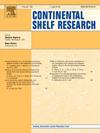Spatial and temporal variability of hydrodynamics on the Amazon Continental Shelf: an observational approach
IF 2.2
3区 地球科学
Q2 OCEANOGRAPHY
引用次数: 0
Abstract
Amazon Continental Shelf (ACS) presents highly energetic hydrodynamics, modulated by multiple forcing mechanisms, and significant socio-economic and climate importance. This study characterizes the spatial-temporal variability of hydrodynamics on the ACS between 2°S and 4°N based on in situ data of 6 coastal sea level stations provided by IBGE, BNDO and SiMCosta, velocity measurements from 201 drifters of NOAA Global Drifter Program and 3 moorings of the AMANDES III project, and 127 CTD profiles from AMANDES and REVIZEE projects. The analysis of the coastal sea level shows that the tidal band contributes for 95 % (Santana, Amapá shelf) to 99 % (Turiaçu and Ribamar, Maranhão shelf) of the temporal variability of the sea level. Moreover, it shows that characteristics typical of a macrotidal regime occur up to 75 % and 41 % of the time at Turiaçu and Salinópolis, the eastern and central regions of the ACS, respectively. Velocity time series from drifters and moorings reveal a northwestward flow pattern along the ACS, which is associated with wind-driven circulation. The semidiurnal tides play a crucial role in the temporal variability of the cross-shelf velocity component, reaching a maximum percentage importance of 90 % on the central region of the ACS. Residual currents (without tides) are more pronounced in the alongshelf component. Their percentage importance increases towards the western shelf, from 68 % (73 %) and 20 % (10 %) in the upper (lower) water column at the eastern shelf, to 95 % (90 %) and 54 % (46 %) in the alongshelf and cross-shelf components, respectively. The wavelet analysis of the residual currents reveals high energy in two distinct period bands between 4 and 20 days and longer than 20 days at all moorings. The first period band is associated with wind modulations, while the second band indicates influence of the North Brazil Current (NBC) fluctuations. The time series of Richardson numbers show that the central and western shelves are stable for most of the time (>70 %). The stratification (N2) and vertical velocity shear (S2) parameters increase toward MAM4 (western shelf) associated with the spreading of the Amazon River plume and the increased influence of the NBC on the speed and direction of currents in the outer shelf. The TS diagrams show the presence of three distinct water masses on the ACS: coastal water influenced by river discharge, mixed water, and oceanic water.
亚马逊大陆架水动力的时空变化:一种观测方法
亚马逊大陆架(ACS)表现出高能量的流体动力学,受多种强迫机制的调节,具有重要的社会经济和气候重要性。基于IBGE、BNDO和SiMCosta提供的6个沿海海平面站的原位数据,NOAA全球漂流计划201艘漂流船和AMANDES III项目3个系泊船的速度测量数据,以及AMANDES和REVIZEE项目的127条CTD剖面,研究了2°S - 4°N区域ACS的水动力时空变化特征。沿海海平面分析表明,潮带对海平面时间变率的贡献率为95%(桑塔纳,amap陆架)至99%(图里阿帕鲁和里巴马尔,maranh陆架)。此外,在东、中部的图里亚帕鲁和Salinópolis,大潮的典型特征分别出现了75%和41%的时间。漂移船和系泊船的速度时间序列揭示了沿ACS向西北方向的流动模式,这与风力环流有关。半日潮对跨大陆架速度分量的时间变化起着至关重要的作用,在太平洋大陆架中部地区的重要性最大,达到90%。残余海流(不含潮汐)在沿陆架部分更为明显。它们的重要性百分比向西大陆架增加,从东部大陆架上(下)水柱的68%(73%)和20%(10%),分别到沿大陆架和跨大陆架成分的95%(90%)和54%(46%)。剩余电流的小波分析显示,在4 ~ 20天的两个不同周期带中,所有系泊的剩余电流都具有高能量,并且在20天以上。第一个周期波段与风的调制有关,而第二个波段表明北巴西流(NBC)波动的影响。理查德森数时间序列表明,中部和西部陆架在大部分时间(70%)是稳定的。分层(N2)和垂直速度剪切(S2)参数向MAM4(西大陆架)方向增大,与亚马孙河羽流扩展和NBC对外大陆架流速和方向的影响增大有关。TS图显示ACS上存在三种不同的水团:受河流排放影响的沿海水、混合水和海水。
本文章由计算机程序翻译,如有差异,请以英文原文为准。
求助全文
约1分钟内获得全文
求助全文
来源期刊

Continental Shelf Research
地学-海洋学
CiteScore
4.30
自引率
4.30%
发文量
136
审稿时长
6.1 months
期刊介绍:
Continental Shelf Research publishes articles dealing with the biological, chemical, geological and physical oceanography of the shallow marine environment, from coastal and estuarine waters out to the shelf break. The continental shelf is a critical environment within the land-ocean continuum, and many processes, functions and problems in the continental shelf are driven by terrestrial inputs transported through the rivers and estuaries to the coastal and continental shelf areas. Manuscripts that deal with these topics must make a clear link to the continental shelf. Examples of research areas include:
Physical sedimentology and geomorphology
Geochemistry of the coastal ocean (inorganic and organic)
Marine environment and anthropogenic effects
Interaction of physical dynamics with natural and manmade shoreline features
Benthic, phytoplankton and zooplankton ecology
Coastal water and sediment quality, and ecosystem health
Benthic-pelagic coupling (physical and biogeochemical)
Interactions between physical dynamics (waves, currents, mixing, etc.) and biogeochemical cycles
Estuarine, coastal and shelf sea modelling and process studies.
 求助内容:
求助内容: 应助结果提醒方式:
应助结果提醒方式:


